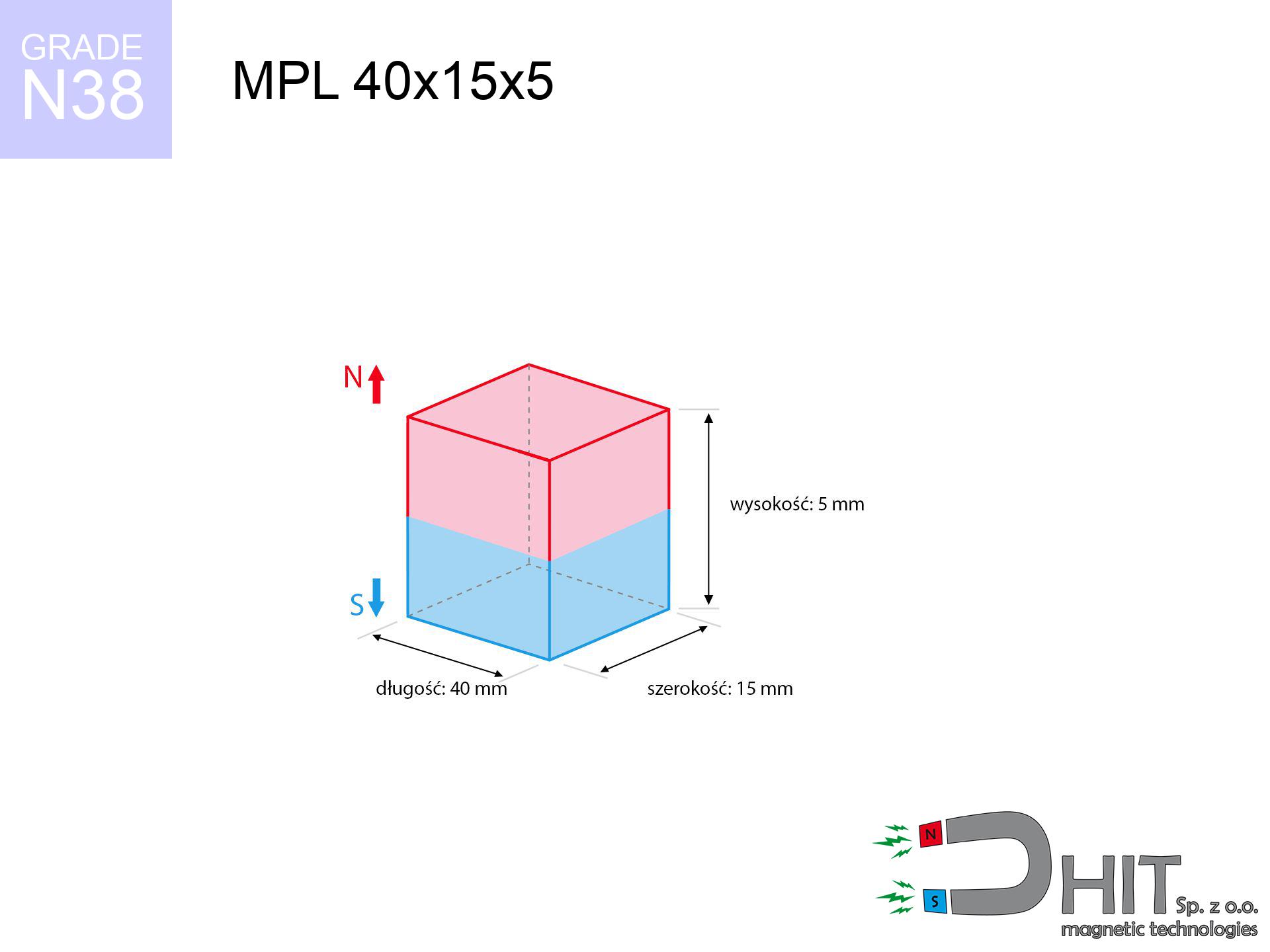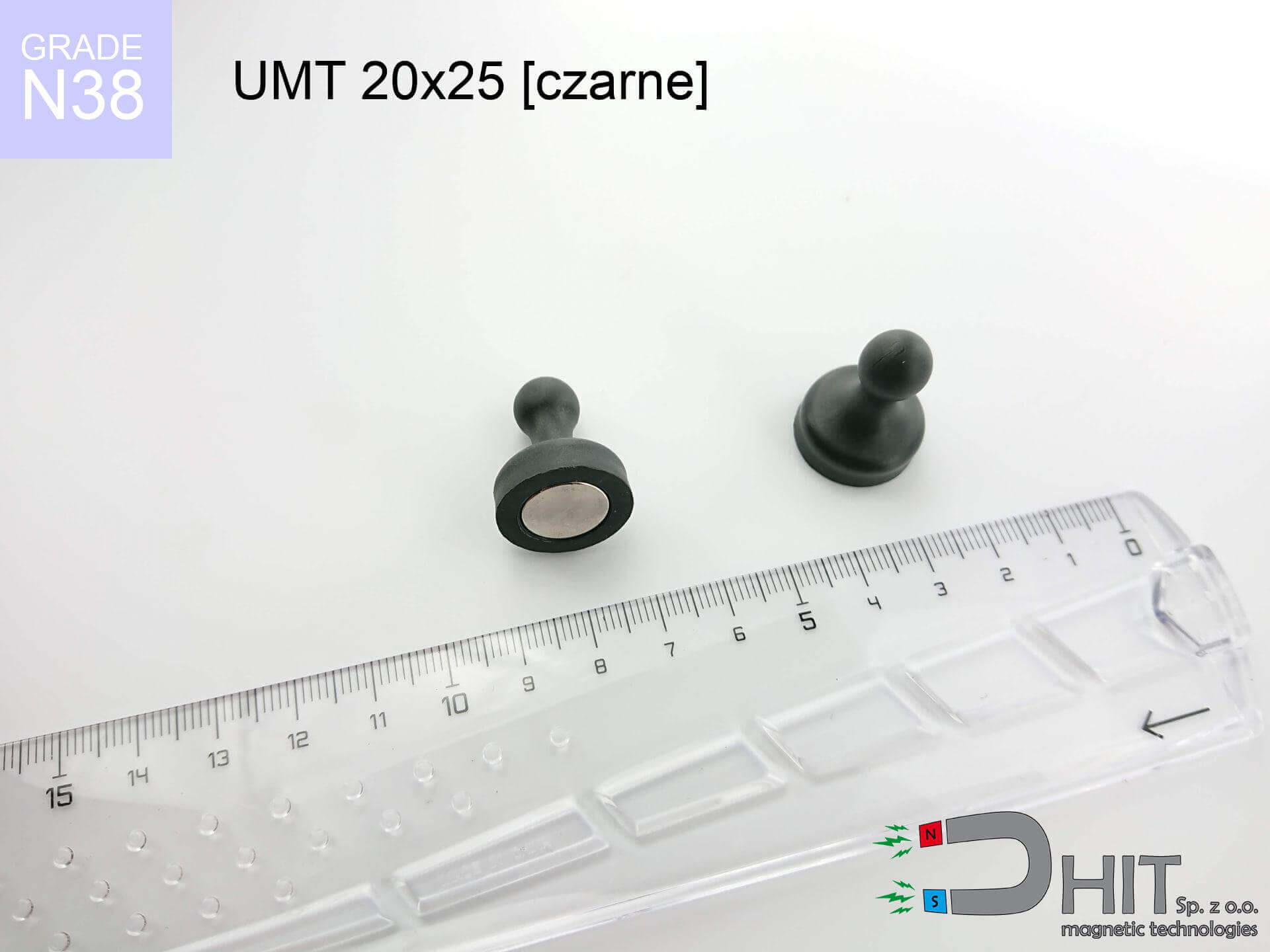MPL 40x15x5 / N38 - lamellar magnet
lamellar magnet
Catalog no 020153
GTIN: 5906301811596
length [±0,1 mm]
40 mm
Width [±0,1 mm]
15 mm
Height [±0,1 mm]
5 mm
Weight
22.5 g
Magnetization Direction
↑ axial
Load capacity
9.67 kg / 94.83 N
Magnetic Induction
249.11 mT
Coating
[NiCuNi] nickel
7.63 ZŁ with VAT / pcs + price for transport
6.20 ZŁ net + 23% VAT / pcs
bulk discounts:
Need more?Not sure which magnet to buy?
Call us
+48 888 99 98 98
alternatively get in touch through
form
the contact section.
Weight and form of a magnet can be tested on our
force calculator.
Order by 14:00 and we’ll ship today!
Magnetic properties of material N38
Physical properties of sintered neodymium magnets Nd2Fe14B at 20°C
Shopping tips
Pros as well as cons of neodymium magnets.
Besides their remarkable strength, neodymium magnets offer the following advantages:
- They do not lose strength, even during around ten years – the reduction in strength is only ~1% (according to tests),
- They do not lose their magnetic properties even under close interference source,
- Thanks to the elegant finish, the surface of Ni-Cu-Ni, gold-plated, or silver-plated gives an visually attractive appearance,
- They show high magnetic induction at the operating surface, which improves attraction properties,
- Due to their durability and thermal resistance, neodymium magnets are capable of operate (depending on the shape) even at high temperatures reaching 230°C or more...
- Possibility of individual shaping as well as adapting to precise requirements,
- Fundamental importance in modern industrial fields – they are utilized in data components, electric drive systems, precision medical tools, and technologically advanced constructions.
- Compactness – despite small sizes they offer powerful magnetic field, making them ideal for precision applications
Cons of neodymium magnets and ways of using them
- Brittleness is one of their disadvantages. Upon intense impact they can break. We advise keeping them in a strong case, which not only secures them against impacts but also raises their durability
- Neodymium magnets decrease their power under the influence of heating. As soon as 80°C is exceeded, many of them start losing their power. Therefore, we recommend our special magnets marked [AH], which maintain durability even at temperatures up to 230°C
- When exposed to humidity, magnets start to rust. To use them in conditions outside, it is recommended to use protective magnets, such as those in rubber or plastics, which prevent oxidation and corrosion.
- We suggest cover - magnetic mechanism, due to difficulties in producing nuts inside the magnet and complex shapes.
- Potential hazard related to microscopic parts of magnets can be dangerous, when accidentally swallowed, which becomes key in the context of child health protection. It is also worth noting that small elements of these magnets can disrupt the diagnostic process medical when they are in the body.
- With budget limitations the cost of neodymium magnets is economically unviable,
Maximum lifting capacity of the magnet – what affects it?
The declared magnet strength refers to the maximum value, measured under optimal environment, meaning:
- on a block made of structural steel, effectively closing the magnetic flux
- with a cross-section minimum 10 mm
- with an ideally smooth contact surface
- under conditions of gap-free contact (surface-to-surface)
- under axial application of breakaway force (90-degree angle)
- in neutral thermal conditions
Determinants of practical lifting force of a magnet
Please note that the magnet holding will differ influenced by the following factors, in order of importance:
- Distance – existence of any layer (paint, tape, gap) interrupts the magnetic circuit, which lowers power steeply (even by 50% at 0.5 mm).
- Force direction – remember that the magnet has greatest strength perpendicularly. Under shear forces, the holding force drops drastically, often to levels of 20-30% of the nominal value.
- Wall thickness – thin material does not allow full use of the magnet. Part of the magnetic field passes through the material instead of generating force.
- Material composition – different alloys reacts the same. High carbon content weaken the interaction with the magnet.
- Base smoothness – the smoother and more polished the surface, the better the adhesion and stronger the hold. Unevenness acts like micro-gaps.
- Temperature – temperature increase results in weakening of force. Check the thermal limit for a given model.
* Lifting capacity was assessed by applying a polished steel plate of suitable thickness (min. 20 mm), under vertically applied force, however under attempts to slide the magnet the lifting capacity is smaller. In addition, even a minimal clearance {between} the magnet and the plate decreases the lifting capacity.
Safety rules for work with neodymium magnets
No play value
These products are not toys. Eating a few magnets may result in them connecting inside the digestive tract, which constitutes a direct threat to life and requires immediate surgery.
Material brittleness
Despite metallic appearance, the material is brittle and cannot withstand shocks. Do not hit, as the magnet may shatter into sharp, dangerous pieces.
Keep away from electronics
GPS units and smartphones are extremely susceptible to magnetic fields. Close proximity with a strong magnet can decalibrate the sensors in your phone.
Implant safety
Patients with a pacemaker should keep an absolute distance from magnets. The magnetism can stop the functioning of the implant.
Crushing force
Large magnets can break fingers in a fraction of a second. Never put your hand betwixt two attracting surfaces.
Thermal limits
Monitor thermal conditions. Heating the magnet above 80 degrees Celsius will destroy its properties and pulling force.
Combustion hazard
Drilling and cutting of neodymium magnets poses a fire hazard. Magnetic powder oxidizes rapidly with oxygen and is hard to extinguish.
Metal Allergy
Warning for allergy sufferers: The Ni-Cu-Ni coating contains nickel. If skin irritation occurs, immediately stop working with magnets and wear gloves.
Safe operation
Before use, read the rules. Sudden snapping can break the magnet or hurt your hand. Think ahead.
Cards and drives
Intense magnetic fields can erase data on credit cards, HDDs, and storage devices. Maintain a gap of min. 10 cm.
Attention!
Looking for details? Check our post: Why are neodymium magnets dangerous?







![UI 45x13x6 [C321] / N38 - badge holder UI 45x13x6 [C321] / N38 - badge holder](https://cdn3.dhit.pl/graphics/products/ui45x13x6-c321-jic.jpg)

